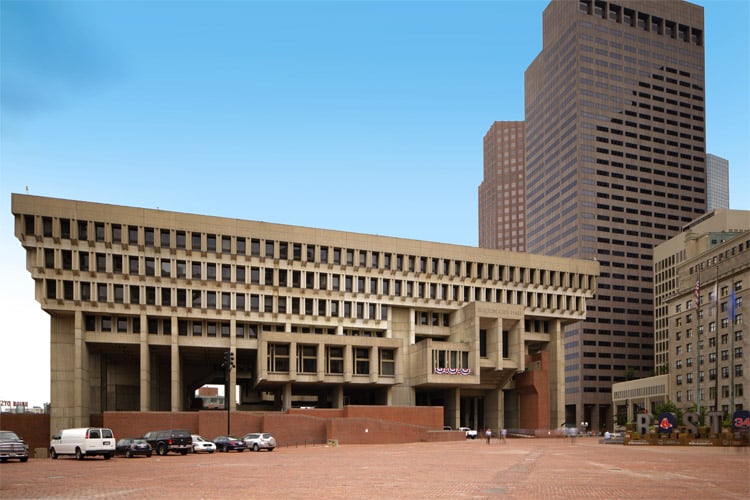Every city has one.
It’s that hulking, seemingly monolithic concrete structure; it’s maybe City Hall, the library or an office building for some government agency, built in a seeming fit of architectural madness in the 1950s or 1960s.
Critics have delighted in likening the huge concrete structures to Soviet-style bunkers or prisons, while the name of the style, Brutalism, appears fitting, connoting a confoundingly grim, inhuman approach to design.
But where many see ugly, even irredeemable structures, a small but impassioned group of supporters see iconic buildings deserving of a second chance—and a style that has been tragically misunderstood.
Thanks to this group of architects, as well as growing climate concerns over large-scale demolition and rebuilding work, a number of monumental, post-war concrete buildings once destined for the dustbin of history have found a new lease on life.
That, in turn, could spark new demand for masonry contractors and others skilled in working with concrete, as city and state officials shift away from demolition of Brutalist structures and grapple with the challenges of restoration, experts say.
“We often remind people that the gorgeous Victorian buildings we love were considered horrible, and a lot of them were torn down and we would like to have them back,” said Greg Galer, executive director of the Boston Preservation Alliance. Brutalist architecture is “increasingly appreciated, even though we are getting a lot of demolitions.”
Misunderstood and despised
Large, Brutalist-style concrete buildings remain unpopular among large contingents of the public. It’s a distaste that set in not long after many of these cutting-edge structures went up in the mid-20th century.
But at least some of the public’s dislike for this style of architecture is based on fundamental misunderstanding, architects say.
Just take the name, Brutalism.
Far from connoting some sort of totalitarian, Big Brother-style of design, Brutalism derives from the French terms for raw concrete—béton brut.
The term was penned by Le Corbusier, the famous Swiss architect and city planner, to describe his work with reinforced concrete.
And the architects who designed these massive concrete buildings were anything but anti-democratic in their motivations and drive, according to Mark Pasnik, a professor of architecture at the Wentworth Institute of Technology and author of “Heroic: Concrete Architecture and the New Boston.”
Consider Boston City Hall. Built in 1968, its nine stories of concrete glory may be one of the best-known examples of Brutalism in the United States, if not the world.
[RELATED: Boston Construction: Tight Spaces, Tiny Jobsites, Historic Considerations]
But the architects, Kallmann, McKinnell and Knowles, not only wanted to make a grand statement, but they also wanted to create a government building that was inviting and open to the public, with many different ways of entering it, according to Pasnik.
“These buildings were all designed in the era of the Great Society,” Pasnik said.
Yet within a few years of Brutalism’s peak in the late 1960s, the style quickly fell into public disfavor.
Misconceptions about Brutalism were soon reinforced by a lack of proper maintenance on these concrete structures—which, as years and then decades passed, began to fall into serious disrepair as facades crumbled and grime accumulated.
By the mid-2000s, public support for Brutalist architecture hit bottom.
In 2005, viewers of “Demolition,” a U.K. TV program, selected a dozen buildings they believed should be demolished, several of them concrete structures built during the heyday of Brutalism.
Around the same time, on the other side of the Atlantic in Boston, late Mayor Thomas M. Menino proposed selling the city’s modern Brutalist icon, City Hall.
The assumption was a commercial developer would buy the long-scorned and deteriorating concrete hulk and demolish it to make way for a new tower or other commercial project.
Saved from the wrecking ball
Menino had hoped to use the money from the sale of City Hall—and the valuable downtown site it is perched on—to build a new, modern municipal palace, with presumably a minimum of concrete, on Boston’s waterfront.
A funny thing happened on the way to the demolition party, however.
Bucking the public disdain for these large, concrete structures, Pasnik and other architects banded together to make a case for saving and restoring the famous brutalist architecture icon of Boston City Hall.

Pasnik’s book, “Heroic,” was an outgrowth of that effort, exploring Boston’s relatively brief but eventful infatuation with concrete that yielded City Hall and dozens of other concrete buildings downtown, part of a larger effort to revive a historic city that had stagnated for decades.
The outpouring of opposition from architects helped slow the momentum, with the Great Recession forcing city officials to shelve their City Hall sale plan indefinitely.
Marty Walsh, the Biden administration’s pick for labor secretary, replaced Menino as mayor in 2014. Walsh supported the sale idea during his campaign, but shifted gears after he took office, with the one-time construction worker and former trade union leader authorizing significant renovations to City Hall as well as the sprawling—and somewhat bare—plaza outside.
The overhaul injected new life into the dark and hulking structure, which had been showing signs of age after years of relative neglect.
A coffee shop selling Nicaraguan java moved into Boston City Hall’s now brightly lit lobby, while city officials reopened a second major entrance to the building after it had been closed and all but forgotten for years.
“I see City Hall in Boston as a model for other buildings like this,” Pasnik said.
Meanwhile, across the country on the University of Washington campus, architects and students rallied to save More Hall Annex, a one-time nuclear reactor built in 1961 in a Brutalist style building.
There was just a single story above ground, encased in concrete, with wide windows designed to let passersby gaze down into the plant in an effort to showcase the safety of nuclear power.
The plant was decommissioned in 1988. Two decades later, plans by the university to tear down the former reactor sparked an eight-year legal fight, with an architecture student leading a successful campaign to add the building to the National Register of Historic Places in 2009.
The building finally came down in 2016, after University of Washington officials prevailed following years of litigation in local courts.
However, preservationists and other supporters of the building, including its original architect, got in the last word, holding a mock funeral for the old reactor building.
“It was this strange little concrete building and, looking into the windows, you could look down into the depths of this thing,” said Alex Anderson, a professor of architecture at the University of Washington. “There was something a little mysterious about having a nuclear reactor in the middle of an urban campus.”
“People still lament the loss of this,” he said.
While the campaign fell short, the reinforced concrete reactor building signaled a growing interest in the architecture of the period, one that now extends beyond just the academic community, Anderson contends.
He points to the Facebook group for Brutalism fans that has more than 100,000 members, while Pasnik cites the more than 100 books he says have been published over the past decade and a half on the architectural trend.
“I think there has been a major shift,” Pasnik said. “The public is growing more interested in them.”
Back to the future
There certainly has been no moratorium on Brutalist buildings meeting the wrecking ball. In January 2021, demolition crews leveled the Burroughs Wellcome building in North Carolina, designed by Paul Rudolph, despite protests from architects and other fans.
But there are signs that both leaders in government and academia are beginning to rethink demolition of these massive concrete structures in favor of renovation or retrofitting.
That could mean increased demand for contractors ready to deal with the many challenges these half-century-old concrete structures pose, from repairing crumbling facades to replacing ancient heating and cooling systems.
Harvard University in Cambridge hired a team of top architects, including Bruner/Cott & Associates in Boston, to overhaul the multi-story, 1960s-era Holyoke Center, since renamed the Smith Campus center.
The architectural team revamped the 360,000-square-foot structure, adding more glass to the lower levels and painstakingly repairing the façade.
That involved methodically tapping across the entire façade, inch by inch, with plastic mallets to check for fissures, while standing outside with binoculars to check for damage as well, said Henry Moss, principal at Bruner/Cott.
Finding the right match for the concrete to be used in the repairs was also challenging, requiring dozens of different candidates before the right one was chosen, Moss noted.
A pair of glazed pavilions was added, while food vendors and seating were installed along an arcade that runs through the center of the ground floor.
Replacing the single-glazed windows, which were major sources of heat loss, was a project in and of itself, involving the scaffolding along the façade and the rather noisy removal of concrete and sealant around the windows.
“This is not something you run into with a Colonial Revival building from 1925,” Moss said. “It’s a very multidimensional problem for the owner.”
Meanwhile, as Brutalist buildings continue to age, there will also likely be increased demand for the services of HVAC contractors and insulation specialists.
These outsized concrete government and university structures were built before the oil crisis of the 1970s, with little attention paid to energy conservation.
The very idea behind Brutalism—the design power of raw concrete—also meant that there is no interior shield or heat brake inside the walls of these buildings.
“It’s concrete inside and out—that was the intention,” Pasnik said. “There was a whole lot of carbon that was released to produce these buildings and demolishing them negates all that. Tearing them down is a poor environmental decision.”
















